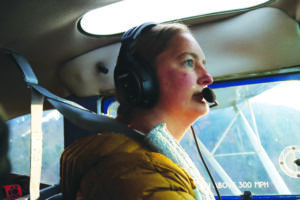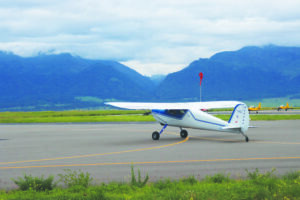
by John Dowd
“Don’t lean on the door or it will pop open,” and, “thankfully, we’re not going to be going fast enough for it to be a big deal,” explains Kelli Weed to those who enter her 1948 Cessna 140. She is one of several small-time pilots that base themselves out of the Stevensville Municipal Airport. For her, flying is a dream come true and as American as apple pie.
“When I started flying I just couldn’t believe that this was something I could do,” said Weed. “People think of private jets, but have no idea this is available to everyone!”

Weed, who tries to maintain her 70-year-old aircraft better than her truck, is not alone in her passion for general aviation and its availability to everyone. “We’re not just rich snobs flying out here. We’re just like you and we just have a passion for it.”
Weed explained that, “A lot of people don’t know that general aviation is for the general public.” Though there are a number of relatively expensive classes and licensing processes, getting a general aviation pilot’s license is something Weed believes is achievable, and to her, worth it.
“I learned to manage risk in an airplane, conquering fear and gaining confidence,” said Weed. “I can’t imagine anything else that does that like this.” Weed, who used to ride horses, compared the freedom of flying with riding. “It’s American heritage, and we’re still doing it!”
Flying goes far back into American history, in fact one of the organizations Weed participates in embodies that history. Chair of the Western Montana branch of the Ninety-Nines, Weed explained that one of the founding members of the organization was one of the most famous pilots of all time, Amelia Earhart. Weed’s chapter is based in Stevensville, and is for the western half of the state. The Ninety-Nines are an international organization of licensed female pilots whose goal is to spread the love and practice of aviation, especially among women.
Along with Earhart were 98 other founding members, from which the organization got its name. The organization provides scholarships to new pilots that helps pay for ratings, which can be some of the most expensive parts of the journey to becoming a pilot.
In Montana, among other places, the organization also paints airport runways. This is a process called air-marking, in which various informative items, such as compasses, elevations and airport names are painted onto the air-strips for pilots to be able to see mid-flight. The Ninety-Nines have air-marked hundreds of airports across the state.
Weed is also a member of the Stevensville Airport Advisory Board, which meets the second Tuesday of every month. The public is welcome to attend airport board meetings and comment during public comment periods. Meetings start at 5:30 p.m. at the Stevensville Town Hall, near the fire station. In fact, the airport encourages the public to attend.
According to Weed, the airport is owned and operated by the Town, which so far does not heed the advice of the board. This makes improving and keeping the airport up to date difficult. There are several things which are in need of improvement and are even in violation of federal guidelines. These things, Weed says, often take upwards of a year to be addressed by the Town. She and others believe much of this comes from a lack of understanding and familiarity with aviation in general. Weed thinks this is something that communicating with the public would help to fix. Without many basic amenities that are common among other even smaller airports, such as courtesy cars, public restrooms and pilot shelters, the airport may not last.
Weed explained that the airport is in desperate need of attention. She also commented that there are numerous grants available to create these things, but without approval from the Town, nothing can be done.
Weed has been flying for three years, and wants to be a professional pilot. She is currently working towards getting her commercial license. Weed contends that small airports, like Stevensville’s, are essential, not just for her passion, but for the community and for the future of aviation. She explained that airports “offer a lot more than people realize. We all started learning in these little rural general aviation airports,” said Weed. “It’s not out of reach!” She explained that rural airports bring aviation to the general public, and provide places for education and entertainment. Numerous other towns across the country hold thousands of events throughout the year at their airport grounds, from car and air shows to aerial displays and classes.
These small airports are also places where interested prospective pilots, young and old, can find scholarships, like the ones provided by the Ninety-Nines. Weed said there are opportunities everywhere. Aside from events, and the jumping off point of many start-up aviators, Weed impressed on how local economies can benefit from general aviation, aside from a location where community events can be held.
According to Weed, municipal airports bring in people from all over, who take aerial road-trips across the country. They often spend time in the many communities in which they land and that also contributes to the local economies. If they have a bad experience, cannot find courtesy vehicles to drive around, or find difficulty getting accommodations, Weed says they will not likely make the same mistake again.
However, most of the local aviators already live in and contribute to the local economy. “Unfortunately, we are just a bunch of ‘bug-beaters’ out here,” said Weed, referring to the many general aviation pilots of the valley, and the many other small airports dotted across the state. “There seems to be this misconception that people who fly are wealthy,” added Weed. She and others would like to get the airport more involved in the community. They want to do an outreach in Stevensville, possibly later this fall, where they want to help address and remedy some perceived dislike or distrust by any locals towards the airport. They also want to show the community the many wonders and values of general aviation, and what the airport can do for the community.
The western Montana branch of the Ninety-Nines meets once a month, the second Saturday of every month. More information on the organization can be found at ninety-nines.org.

Mike Miller says
How is this “news”?